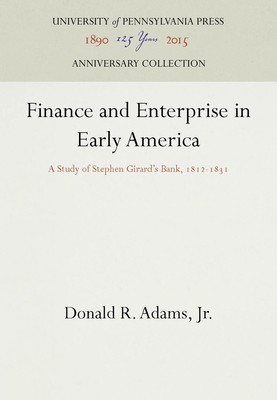
- We will send in 10–14 business days.
- Author: Jr
- Publisher: University of Pennsylvania Press Anniversary Collection
- ISBN-10: 0812277368
- ISBN-13: 9780812277364
- Format: 15.6 x 23.4 x 1.1 cm, kieti viršeliai
- Language: English
- SAVE -10% with code: EXTRA
Reviews
Description
Stephen Girard, the second richest American of his time after John Jacob Astor, was the last of the great merchant bankers and the first of the great investment bankers. This is a study not only of an influential man and the bank he operated in Philadelphia but also of the growing interdependence between the institutions of government and finance in early nineteenth-century America.
In a period when precedents were being set in a new nation and large corporations were beginning to predominate in the business of banking, Girard, a man of undisputed business acumen, established in Philadelphia what was to become the largest private bank of its time and as such a monument to free enterprise. At the same time, along with Astor and other influential financiers, Girard was instrumental in financing the War of 1812 and in establishing the second Bank of the United States. His close association with the Madison administration and the Treasury Department made him a key figure in the evolving relationship between the federal government and the financial community. Applying modern statistical techniques to the comprehensive records of the old Girard Bank, Donald Adams has uncovered a great deal of information, hitherto largely unavailable to scholars, about banking practices in early America. In this book he analyzes day-to-day operations--the kinds of loans that were typical, the devices for maintaining liquidity, the organization of staff--as well as long-run investment decisions and their impact on the formation of American finance. While other studies have been made of the anatomy and influence of early chartered and corporate banks, Adams' is the first history of America's largest private bank. It provides a rare glimpse of the inner structure and strategy of an important financial institution and of the entrepreneurial and political activities of its founder.EXTRA 10 % discount with code: EXTRA
The promotion ends in 23d.08:55:41
The discount code is valid when purchasing from 10 €. Discounts do not stack.
- Author: Jr
- Publisher: University of Pennsylvania Press Anniversary Collection
- ISBN-10: 0812277368
- ISBN-13: 9780812277364
- Format: 15.6 x 23.4 x 1.1 cm, kieti viršeliai
- Language: English English
Stephen Girard, the second richest American of his time after John Jacob Astor, was the last of the great merchant bankers and the first of the great investment bankers. This is a study not only of an influential man and the bank he operated in Philadelphia but also of the growing interdependence between the institutions of government and finance in early nineteenth-century America.
In a period when precedents were being set in a new nation and large corporations were beginning to predominate in the business of banking, Girard, a man of undisputed business acumen, established in Philadelphia what was to become the largest private bank of its time and as such a monument to free enterprise. At the same time, along with Astor and other influential financiers, Girard was instrumental in financing the War of 1812 and in establishing the second Bank of the United States. His close association with the Madison administration and the Treasury Department made him a key figure in the evolving relationship between the federal government and the financial community. Applying modern statistical techniques to the comprehensive records of the old Girard Bank, Donald Adams has uncovered a great deal of information, hitherto largely unavailable to scholars, about banking practices in early America. In this book he analyzes day-to-day operations--the kinds of loans that were typical, the devices for maintaining liquidity, the organization of staff--as well as long-run investment decisions and their impact on the formation of American finance. While other studies have been made of the anatomy and influence of early chartered and corporate banks, Adams' is the first history of America's largest private bank. It provides a rare glimpse of the inner structure and strategy of an important financial institution and of the entrepreneurial and political activities of its founder.

Reviews